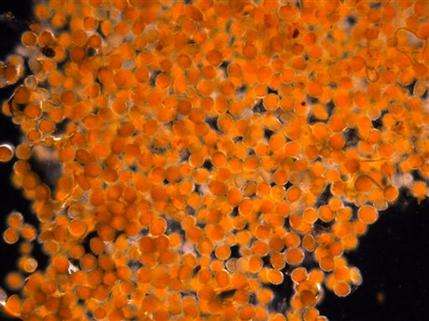Orange goo near remote Alaska village ID'd as eggs

(AP) -- Scientists have identified an orange-colored gunk that appeared along the shore of a remote Alaska village as millions of microscopic eggs filled with fatty droplets.
But the mystery is not quite solved. Officials with the National Oceanic and Atmospheric Administration said Monday they don't know for sure what species the eggs are, although they believe they are some kind of crustacean eggs or embryos. They also don't know if the eggs are toxic, and that worries many of the 374 residents of Kivalina, an Inupiat Eskimo community located at the tip of an 8-mile barrier reef on Alaska's northwest coast.
There's been at least one report of dead minnows found in the lagoon of the village the night the eggs appeared last week. Residents also are worried about the community's dwindling reserves in village water tanks even though the orange mass has dissipated from the lagoon and Wulik River, said city administrator Janet Mitchell.
"It seems to be all gone," she said. "But if they're microscopic eggs, who's to say they're not still in the river?"
Scientists also don't know why the unidentified eggs suddenly emerged on the shores of Kivalina last week. Villagers say they've never seen such a phenomenon before.
"We'll probably find some clues, but we'll likely never have a definitive answer on that," NOAA spokeswoman Julie Speegle said.
Samples are being sent to a NOAA laboratory in Charleston, S.C., for further analysis. The Alaska Department of Environmental Conservation also sent samples Monday to the Institute for Marine Science at the University of Alaska Fairbanks.
Kivalina residents live largely off the land, and many are worried about the effect on some wildlife and plants from the goo, which turned powdery once it dried - and probably went airborne. Mitchell said some people went berry picking over the weekend, but couldn't tell if the goo was on the fruit, called salmonberries, which are the same color of the eggs. The caribou are in the region now, but she doesn't believe the migrating animals pose much risk as a food source.
The eggs were found on at least one roof and in buckets set all over the village to collect rain water. City Councilwoman Frances Douglas said the gooey, slimy substance was widely spread in streaks along the Wulik River and the lagoon, which is a half mile wide and six miles long. Orangey water was reported from as far away as the village of Buckland, 150 miles southeast of Kivalina.
Douglas estimated the volume of eggs she could see "in excess of a thousand gallons, easily."
The weather last Wednesday, when the bright substance emerged, only intensified the effect, according to Douglas.
"We had an overcast sky, so it really, really stood out," she said. "You couldn't miss it for nothing."
Even village elders don't recall anything like it, said Douglas, who has lived all her 44 years in Kivalina. She remembers temperatures were colder in her childhood, gradually rising over the years. She wonders if that has anything to do with the invasion of the eggs.
"With climate change, anything can happen, I guess," she said.
Speegle called the climate change theory "purely speculative."
©2011 The Associated Press. All rights reserved. This material may not be published, broadcast, rewritten or redistributed.


















